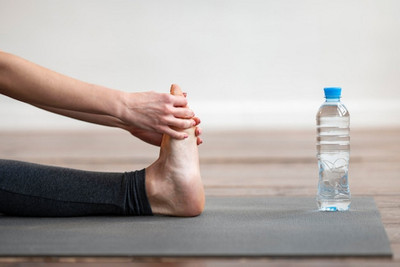TOP 5 JOINT-STRENGTHENING EXERCISES TO REDUCE JOINT PAIN
MD Formula on Jan 17th 2024
Having good health without exercising is like squeezing water from a stone; you need to work out regularly to stay healthy and prevent or manage disorders like hypertension and diabetes mellitus. Unfortunately, conditions that affect the joints, such as arthritis, gout, lupus, and bursitis, make it challenging to work out effectively by limiting the range of motion and increasing pain. But don't worry. In this blog post, I will share the top five exercises you can participate in if you suffer from joint pain and stiffness. These exercises strengthen your joints while keeping you active enough to achieve your health and fitness goals.
CAN MY JOINTS REALLY GET STRONGER?
The simple answer is yes. There are several ways to strengthen your joints regardless of the root cause. Some of these ways include:
⦁ Dieting
⦁ Taking joint hydration supplements like MD Formula

⦁ Having a healthy lifestyle
⦁ Exercise: This systematic review revealed that exercise is a better choice for strengthening the joints as compared to treatment with medication, injections, and surgeries.
WHY IS JOINT STRENGTHENING SO IMPORTANT?
There are so many reasons why you should consider joint strengthening exercises: These include;
⦁ To reduce the risk of injury: You should strengthen your joints as you age, strong joints help reduce the risk of injury.
⦁ Enhance Joint function: When you have strong joints, it will be easier to perform everyday activities like walking, sitting, lifting, and standing.
⦁ Manage joint pain: Performing joint strengthening exercises regularly increases lubrication of the joint cartilage, thereby reducing pain and stiffness.
⦁ To prevent joint degeneration: As we age, our bones and muscles become weaker. The more we engage our muscles and joints the slower it is for them to degenerate.
EXERCISES FOR JOINT STRENGTH
⦁ Low-Impact Cardio
Low-impact cardio like swimming, cycling, and walking places less pressure on the joints while engaging the body. It also helps with weight management, which is recommended for joint strengthening. For instance, swimming is one of the best full-body workouts for people with joint problems. The water supports your body and joints while providing sufficient resistance to build strength.
Research proves that swimming regularly reduces joint pain and stiffness associated with osteoarthritis (OA), and also improves muscle strength and function in middle-aged and older adults with OA.
Low-impact cardio is also great for the cardiovascular system.
2. Yoga
Yoga is another exercise to consider if you are seeking to strengthen your joints. Yoga postures like tree pose, bow pose, plank pose, bridge pose, and bound angle pose have been proven to improve muscular strength and flexibility in people with arthritis. As you work to maintain these postures, the muscles surrounding these joints strengthen. Yoga stretches your joints and muscles while providing a lower risk of injury and preventing or delaying arthritis.
3. Pilates
Pilates is designed to promote flexibility, improve posture, and enhance physical and mental strength. These are also low-impact exercises, which means they are gentler on the joints. If you have joint pain or stiffness in your knees, shoulders, or hips, you should start practicing Pilates for joint strengthening.
4. Tai Chi
This ancient Chinese practice is for people with joint disorders and healthy people seeking to protect their joints. According to the Osteoarthritis Foundation International, Tai chi not only manages the symptoms of joint disorders like arthritis but also reduces the risk of occurrence in healthy people. This exercise enhances joint lubrication and range of motion due to its slow, controlled movements.
5. Resistance Training
Experts say that resistance training using weights or bands can improve joint health. Applying some force with controlled movement strengthens the bones and muscles surrounding your joints. You require less effort to function if your bones and muscles are strong. It is crucial to start with light weights and focus on proper posture to avoid joint injury.
However, according to Harvard Health Publishing, resistance training is not recommended for people with inflamed joints.
TIPS TO PREVENT JOINT INJURIES WHEN EXERCISING
⦁ ALWAYS WARM UP BEFORE WORKING OUT
Diving right into main exercises puts too much stress on the muscles and joints, but warming up sets the tone and prepares you mentally and physically for your session. Examples of warm-up exercises for people with joint issues include walking on the treadmill and arm swings.
2. FOCUS ON PROPER FORM IN EVERY EXERCISE
This is crucial in preventing injuries, especially resistance training or exercises involving weights and accessories. Prioritize proper form or postures for progressive building. For instance, keeping your shoulder aligned with your pelvis as much as possible helps prevent lower back pain.
3. KNOW YOUR LIMIT
You should know how heavy you can carry, how fast or slow you can go, or how many reps you can handle. Everyone is different; what one person can comfortably do varies from what you can survive. The trick is to start with your minimum and keep progressing according to your strength.
4. REMEMBER TO STRETCH AFTER EXERCISING
Stretching helps cool down and relax the muscles. There are many benefits to stretching after exercising, including preventing pain or muscle soreness by eliminating lactic acid, improving blood circulation, increasing flexibility, and reducing joint injury.
5. REST IS CRUCIAL
Rest days are equally important as workout days when it comes to muscle building and joint health because it promotes recovery. Aim for 1-3 rest days per week.
FINAL WORDS
Joint-strengthening exercises like swimming, cycling, yoga, pilates, Tai Chi, and resistance training are essential in managing joint pain and stiffness. These exercises, coupled with dieting, a healthy lifestyle, and high-quality joint hydration supplements like MD Formula, have proven to strengthen the joint, reduce joint pain and stiffness, and increase joint function significantly in people with joint disorders or healthy people seeking to protect their joints.

